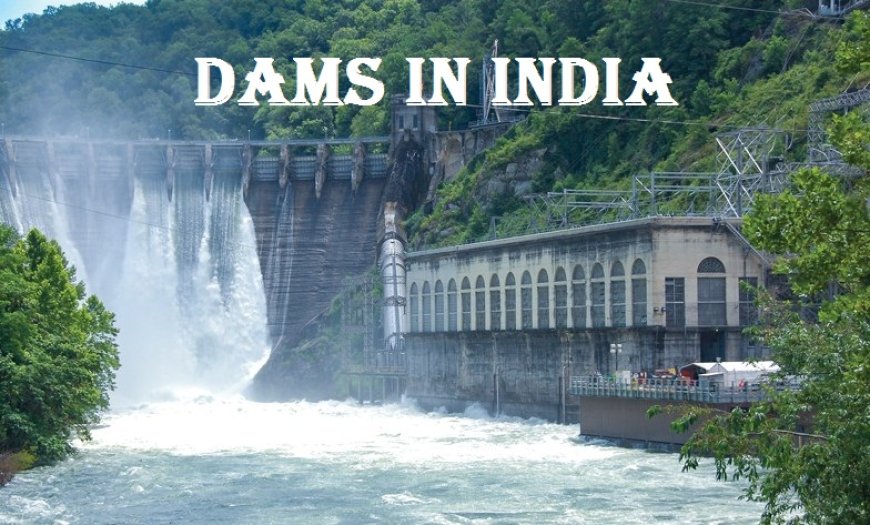Dams in India

Dams in India
India, a land of rivers has a huge potential for the construction of massive dams, owing to its geographical features.
In the north lies the Himalayan Mountains, in middle India lies the Plateaus, whereas in southern India has Western and
Eastern Ghats along the ocean boundaries of the country. India has already constructed a huge number of several
dams and water reservoirs, with approximately 4300 already-constructed large dams.
What is Dam?
A dam is a barrier that stops the flow of water and results in the creation of a reservoir. Dams are mainly built in order to
produce electricity by using water. This form of electricity is known as hydroelectricity.
Reservoirs created by dams not only suppress floods but also provide water for activities such as irrigation, human consumption, industrial use, aquaculture, and navigability.
Types of Dams
There are many dams in India, and hence there is a need to know about them as there are questions based on the dams of India.
Based on the structure the types of dams are as mentioned below:
- Barrages: A barrage is a type of low-head, diversion dam which consists of a number of large gates that can be opened or closed to control the amount of water passing through. This allows the structure to regulate and stabilize river water elevation upstream for use in irrigation and other systems.
- Embankment Dams: An embankment dam is a large artificial dam. It is typically created by the placement and compaction of a complex semi-plastic mound of various compositions of soil, sand, clay, or rock. It has a semi-pervious waterproof natural covering for its surface and a dense, impervious core.
- Rock-Fills Dams: Rock-fill dams are embankments of compacted free-draining granular earth with an impervious zone. The earth utilized often contains a high percentage of large particles, hence the term “rock-fill”.
- Concrete-face rock-fill dams: A concrete-face rock-fill dam (CFRD) is a rock-fill dam with concrete slabs on its upstream face. This design provides the concrete slab as an impervious wall to prevent leakage and also a structure without concern for uplift pressure.
- Earth-fill dams: Earth-fill dams, also called earthen dams, rolled-earth dams or simply earth dams, are constructed as a simple embankment of well-compacted earth. A homogeneous rolled-earth dam is entirely constructed of one type of material but may contain a drain layer to collect seep water.
- Arch Dam: An arch dam is a concrete dam that is curved upstream in the plan. It is designed so that the hydrostatic pressure (force of the water against it) presses against the arch, causing the arch to straighten slightly and strengthening the structure as it pushes into its foundation or abutments. An arch dam is most suitable for narrow canyons or gorges with steep walls of stable rock to support the structure and stresses.
- Gravity Dam: Dams constructed from concrete or stone masonry are Gravity dams. They are designed to hold back water by using only the weight of the material and its resistance against the foundation to oppose the horizontal pressure of water pushing against it. These are designed in such a way that each section of the dam is stable and independent of other section.
- Arch-Gravity Dam: This dam has the characteristics of both an arch dam and a gravity dam. It is a dam that curves upstream in a narrowing curve that directs most of the water pressure against the canyon rock walls. The inward compression of the dam by the water reduces the lateral (horizontal) force acting on the dam.
Uses of Dams in India
Check some of the important points about the dams. How dams are useful in the modern world for society.
➤ River navigation - it is the cheapest form of transportation.
➤ Dams Reservoirs are used for fishing and boating purposes, thus providing livelihood to many.
➤ They are useful to control the flow of rivers, helping in flood conditions.
➤ Providing adequate water for domestic and city use,
➤ Water supply for irrigation purposes,
➤ Water is needed for many industries,
➤ Hydroelectric power production,
Major Dams in India
| Name of Dam | State Name | River Name |
| Nizam Sagar Dam | Telangana | Manjira River |
| Somasila Dam | Andhra Pradesh | Pennar River |
| Srisailam Dam | Andhra Pradesh | Krishna River |
| Singur dam | Telangana | Manjira River |
| Ukai Dam | Gujarat | Tapti River |
| Dharoi Dam | Gujarat | Sabarmati River |
| Kadana dam | Gujarat | Mahi River |
| Dantiwada Dam | Gujarat | Banas River |
| Pandoh Dam | Himachal Pradesh | Beas River |
| Bhakra Nangal Dam | Himachal Pradesh and Punjab Border | Sutlej River |
| Nathpa Jhakri Dam | Himachal Pradesh | Satluj River |
| Chamera Dam | Himachal Pradesh | Ravi River |
| Baglihar Dam | Jammu and Kashmir | Chenab River |
| Dumkhar Hydroelectric Dam | Jammu and Kashmir | Indus River |
| Uri Hydroelectric Dam | Jammu and Kashmir | Jhelum River |
| Maithon Dam | Jharkhand | Barakar River |
| Chandil Dam | Jharkhand | Swarnarekha River |
| Panchet Dam | Jharkhand | Damodar River |
| Tunga Bhadra Dam | Karnataka | Tungabhadra River |
| Linganamakki dam | Karnataka | Sharavathi River |
| Kadra Dam | Karnataka | Kalinadi River |
| Alamatti Dam | Karnataka | Krishna River |
| Supa Dam | Karnataka | Kalinadi or Kali river |
| Krishna Raja Sagara Dam | Karnataka | Kaveri River |
| Harangi Dam | Karnataka | Harangi River |
| Narayanpur Dam | Karnataka | Krishna River |
| Kodasalli Dam | Karnataka | Kali River |
| Malampuzha Dam | Kerala | Malampuzha River |
| Peechi Dam | Kerala | Manali River |
| Idukki Dam | Kerala | Periyar River |
| Kundala Dam | Kerala | Kundala Lake |
| Parambikulam Dam | Kerala | Parambikulam River |
| Walayar Dam | Kerala | Walayar River |
| Mullaperiyar Dam | Kerala | Periyar River |
| Neyyar Dam | Kerala | Neyyar River |
| Rajghat Dam | Uttar Pradesh and Madhya Pradesh Border | Betwa River |
| Barna Dam | Madhya Pradesh | Barna River |
| Bargi Dam | Madhya Pradesh | Narmada River |
| Bansagar Dam | Madhya Pradesh | Sone River |
| Gandhi Sagar Dam | Madhya Pradesh | Chambal River |
| Yeldari Dam | Maharashtra | Purna river |
| Ujani Dam | Maharashtra | Bhima River |
| Pawna Dam | Maharashtra | Maval River |
| Mulshi Dam | Maharashtra | Mula River |
| Koyna Dam | Maharashtra | Koyna River |
| Jayakwadi Dam | Maharashtra | Godavari River |
| Bhatsa Dam | Maharashtra | Bhatsa river |
| Wilson Dam | Maharashtra | Pravara River |
| Tansa Dam | Maharashtra | Tansa river |
| Panshet Dam | Maharashtra | Ambi River |
| Mula Dam | Maharashtra | Mula river |
| Kolkewadi Dam | Maharashtra | Vashishti River |
| Girna Dam | Maharashtra | Girana river |
| Vaitarna Dam | Maharashtra | Vaitarna river |
| Radhanagari Dam | Telangana | Bhogawati River |
| Lower Manair Dam | Telangana | Manair River |
| Mid Manair Dam | Telangana | Manair River and SRSP Flood Flow Canal |
| Upper Manair Dam | Telangana | Manair River and Kudlair River |
| Khadakwasla Dam | Maharashtra | Mutha River |
| Gangapur Dam | Maharashtra | Godavari river |
| Jalaput Dam | Andhra Pradesh and Odisha Border | Machkund River |
| Indravati Dam | Odisha | Indravati River |
| Hirakud Dam | Odisha | Mahanadi River |
| Vaigai Dam | Tamil Nadu | Vaigai River |
| Perunchani Dam | Tamil Nadu | Paralayar River |
| Mettur Dam | Tamil Nadu | Kaveri River |
| Govind Ballabh Pant Sagar Dam / Rihand dam | Uttar Pradesh | Rihand River |
| Tehri Dam | Uttarakhand | Bhagirathi River |
| Dhauli Ganga Dam | Uttarakhand | Dhauli Ganga River |
Longest Dam in India
Hirakud Dam is the longest dam in India. The Hirakud Dam is built on the Mahanadi river in Sambalpur district in Odisha state. The total length of the Hirakud Dam is 25.79 km and the length of the main dam is 4.8 km. Hirakud Dam was completed in 1953.
- Height of the Dam- 61 m
- Length of the Dam- 4.8 km (Main Dam)
- Type of Dam- Composite Dam
- The reservoir capacity- 47,79,965 acre feet
- Capacity that is installed- 347.5 Megawatt
Highest Dam in India
Tehri Dam is the highest or tallest dam in India and the 12th tallest dam in the world. The Tehri Dam is built on the Bhagirathi River in New Tehri, Tehri Garhwal district in Uttarakhand state, India. The height of the Tehri dam is 260 meters and the length is 575 meters. The first phase of the Tehri Dam was completed in 2006. It comes under THDC India Ltd. and the Tehri hydroelectric complex.
- Height of the Dam- 260.5 m
- Length of the Dam- 575 m
- Type of Dam- Rock fill
- The reservoir capacity- 21,00,000 acre feet
- Capacity that is installed- 1000 Megawatt
Oldest Dam in India
Kallanai Dam on the Kaveri river is the oldest dam in India. It is located in the Thanjavur district of Tamil Nadu state. Kallanai Dam was completed in 100 BC –100 AD and now it is operated by the Government of Tamil Nadu.
What's Your Reaction?

























































